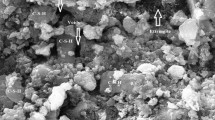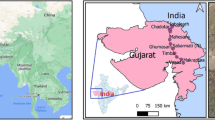Abstract
The uniaxial compressive strength and static Young’s modulus are among the key design parameters typically used in geotechnical engineering projects. In this paper, three artificial intelligence techniques, namely the local linear neuro-fuzzy (LLNF) technique, artificial neural network (ANN) and the hybrid cuckoo optimization algorithm-artificial neural network (COA-ANN), were used to estimate the uniaxial compressive strength and the static Young’s modulus of limestone. For this purpose, 115 limestone samples were subjected to the tests of uniaxial compressive strength, ultrasonic velocity, and physical properties (density and porosity) tests. From the laboratory results obtained, the values of the P-wave velocity, density, porosity and dynamic Poisson’s ratio were tested as the model input parameters to determine the best input configuration for estimating the uniaxial compressive strength and the static Young’s modulus. Different models with different input combinations were practiced, and the models with the highest estimation accuracy are reported here. Performance evaluation was carried out using three criteria including coefficient of determination, variance accounted for, and normalized mean-square error. Evaluating the correlation coefficients and error criteria resulting from the three methods used demonstrates the superiority of LLNF method to ANN and COA-ANN methods. The developed ANN models display lower correlation coefficients and higher amount of error compared to the other models. However, using cuckoo optimization algorithm has led to significant improvement in accuracy and precision of estimations carried out by ANN and has improved its efficiency. Results have confirmed that the employed hybrid method outperforms in estimating untrained data (test data) compared to the LLNF and ANN methods.











Similar content being viewed by others
References
Alemdag, S., Gurocak, Z., & Gokceoglu, C. (2015). A simple regression-based approach to estimate deformation modulus of rock masses. Journal of African Earth Sciences, 110, 75–80.
Ali, E., Guang, W., & Ibrahim, A. (2014). Empirical relations between compressive strength and microfabric properties of amphibolites using multivariate regression, fuzzy inference and neural networks: A comparative study. Engineering Geology, 183(9), 230–240.
Aminzadeh, F., & Brouwer, F. (2006). Integrating neural network and fuzzy logic for improved reservoir property prediction and prospect ranking. SEG Technical expanded abstracts, doi, 10(1190/1), 2369863.
ASTM (American Society for Testing and Materials). (1984). Annual book of ASTM standards 4.08. ASTM, Philadelphia, PA.
Baykasoglu, A., Dereli, T., & Tanis, S. (2004). Prediction of cement strength using soft computing techniques. Cement and Concrete Research, 34(11), 2083–2090.
Billings, S., Korenberg, M., & Chen, S. (1998). Identification of nonlinear output-affine systems using an orthogonal least-squares algorithm. International Journal of System Science, 19(8), 1559–1568.
Briševac, Z., Hrženjak, P., & Buljan, R. (2016). Models for estimating uniaxial compressive strength and elastic modulus. Građevinar, 68(1), 19–28. https://doi.org/10.14256/JCE.1431.2015.
Ceryan, N., Okkan, U., & Kesimal, A. (2012). Prediction of unconfined compressive strength of carbonate rocks using artificial neural networks. Environmental Earth Sciences, 68(3), 807–819.
Dehghan, S., Sattari, G. H., Chehreh, C. S., & Aliabadi, M. A. (2010). Prediction of unconfined compressive strength and modulus of elasticity for Travertine samples using regression and artificial neural networks. Mining Science and Technology (China), 20(1), 41–46. https://doi.org/10.1016/S1674-5264(09)60158-7.
Dincer, I., Acar, A., & Ural, S. (2008). Estimation of strength and deformation properties of quaternary Caliche deposits. Bulletin of Engineering Geology and the Environment, 67(3), 353–366.
Fairhurst, C. E., & Hudson, J. A. (1999). Draft ISRM suggested method for the complete stress-strain curve for intact rock in uniaxial compression. International Journal of Rock Mechanics and Mining Sciences, 36(3), 279–289.
Fjar, E., Holt, R. M., Raaen, A. M., Risnes, R., & Horsrud, P. (2008). Petroleum related rock mechanics (Vol. 53, pp. 325–327). New York: Elsevier.
Garrett, J. H. (1994). Where and why artificial neural networks are applicable in civil engineering. Journal of Computing in Civil Engineering, 8(2), 129–130.
Ghafoori, M., Rastegarnia, A., & Lashkaripour, G. R. (2018). Estimation of static parameters based on dynamical and physical properties in limestone rocks. Journal of African Earth Sciences, 137, 22–31.
Goh, A. T. C. (2001). Neural network applications in geotechnical engineering. Scientia Iranica, 8(1), 1–9.
Gunset, R. F. (1983). Regression analysis with multicollinear predictor variables: definition, detection, and effects. Communications in Statistics, 12(19), 2217–2260.
Haykin, S. (1999). Neural networks (2nd ed.). Englewood Cliffs, NJ: Prentice-Hall.
ISRM. (2007). The complete ISRM suggested methods for rock characterization, testing and monitoring: 1974-2006. In R. Ulusay & J. A. Hudson (Eds.), Suggested methods prepared by the commission on testing methods. Ankara: International Society for Rock Mechanics, ISRM Turkish National Group.
Jahed Armaghani, D., Amin, M. F. M., Yagiz, S., Shirani Faradonbeh, R., & Asnida Abdullah, R. (2016). Prediction of the uniaxial compressive strength of sandstone using various modeling techniques. International Journal of Rock Mechanics and Mining Sciences, 85, 174–186.
Jang, J., Sun, C., & Mizutani, E. (1997). Fuzzy-neuro and soft computing: a computational approach to learning and machine intelligence. Upper saddle river, New Jersey: Prentice hall.
Kahraman, S. (2001). Evaluation of simple methods for assessing the uniaxial compressive strength of rock. International Journal of Rock Mechanics and Mining Sciences, 38(7), 981–994.
Kahraman, S., Fener, M., & Gunaydin, O. (2017). Estimating the uniaxial compressive strength of pyroclastic rocks from the slake durability index. Bulletin of Engineering Geology and the Environment, 76(3), 1107–1115.
Kilic, A., & Teymen, A. (2008). Determination of mechanical properties of rocks using simple methods. Bulletin of Engineering Geology and the Environment. https://doi.org/10.1007/s10064-008-0128-3.
Majdi, A., & Rezaei, M. (2013). Prediction of unconfined compressive strength of rock surrounding a roadway using artificial neural network. Neural Computing and Applications, 23(2), 381–389.
Maji, V. B., & Sitharam, T. G. (2008). Prediction of elastic modulus of jointed rock mass using artificial neural network. Geotechnical and Geological Engineering, 26(4), 443–452.
Meulenkamp, F., & Grima, M. A. (1999). Application of neural network for the prediction of the unconfined compressive strength (UCS) from Equotip hardness. International Journal of Rock Mechanics and Mining Sciences, 36(1), 29–33.
Mishra, D. A., & Basu, A. (2013). Estimation of uniaxial compressive strength of rock materials by index tests using regression analysis and fuzzy inference system. Engineering Geology, 160(27), 54–68.
Monjezi, M., Khoshalan, H. A., & Razifard, M. (2012). A neuro-genetic network for predicting uniaxial compressive strength of rocks. Geotechnical and Geological Engineering, 30(4), 1053–1062.
Moradian, Z. A., & Behnia, M. (2009). Predicting the uniaxial compressive strength and static Young’s modulus of intact sedimentary rocks using the ultrasonic test. International Journal of Geomechanics, 9(1), 14–19.
Nelles, O. (2001). Nonlinear system identification. Berlin: Springer.
Ozturk, H., & Altinpinar, M. (2017). The estimation of uniaxial compressive strength conversion factor of trona and interbeds from point load tests and numerical modeling. Journal of African Earth Sciences. https://doi.org/10.1016/j.jafrearsci.2017.04.015.
Rajabioun, R. (2011). Cuckoo optimization algorithm. Applied Soft Computing, 11(8), 5508–5518.
Shalabi, F., Cording, E. J., & Al-Hattamleh, O. H. (2007). Estimation of rock engineering properties using hardness tests. Engineering Geology, 90(3–4), 138–147.
Sharma, L. K., Vishal, V., & Singh, T. N. (2017). Developing novel models using neural networks and fuzzy systems for the prediction of strength of rocks from key geomechanical properties. Journal of Measurement, 102, 158–169.
Singh, V. K., Singh, D., & Singh, T. N. (2001). Prediction of strength properties of some schistose rocks from petrographic properties using artificial neural networks. International Journal of Rock Mechanics and Mining Sciences, 38(2), 269–284.
Starzec, P. (1999). Dynamic elastic properties of crystalline rocks from south-west Sweden. International Journal of Rock Mechanics and Mining Sciences, 36(2), 265–272.
Tiryaki, B. (2008). Predicting intact rock strength for mechanical excavation using multivariate statistics, artificial neural networks, and regression trees. Engineering Geology, 99(1–2), 51–60.
Tonnizam Mohamad, E., Jahed Armaghani, D., Momeni, E., & Alavi Nezhad Khalil Abad, S. V. (2015). Prediction of the unconfined compressive strength of soft rocks: a PSO- based ANN approach. Bulletin of Engineering Geology and the Environment, 74(3), 745–757.
Torabi-Kaveh, M., Naseri, F., Saneie, S., & Sarshari, B. (2015). Application of artificial neural networks and multivariate statistics to predict UCS and E using physical properties of Asmari limestones. Arabian Journal of Geosciences, 8(5), 2889–2897.
Vutukuri, V. S., Lama, R. D., & Saluja, S. S. (1974). Handbook on mechanical properties of rocks-testing techniques and results—volume I (pp. 32–61). Germany: Trans Tech Publications.
Yagiz, S., Sezer, E. A., & Gokceoglu, C. (2012). Artificial neural networks and nonlinear regression techniques to assess the influence of slake durability cycles on the prediction of uniaxial compressive strength and modulus of elasticity for carbonate rocks. International Journal for Numerical and Analytical Methods in Geomechanics, 36, 1636–1650.
Yang, X.-S., & Deb, S. (2010). Engineering optimization by cuckoo search. International Journal of Mathematical Modelling and Numerical Optimisation, 1(14), 330–343.
Yasar, E., & Erdogan, Y. (2004). Estimation of rock physico mechanical properties using hardness methods. Engineering Geology, 71, 281–288.
Yesiloglu-Gultekin, N., Gokceoglu, C., & Sezer, E. A. (2013a). Prediction of uniaxial compressive strength of granitic rocks by various nonlinear tools and comparison of their performances. International Journal of Rock Mechanics and Mining Sciences, 62, 113–122.
Yesiloglu-Gultekin, N., Sezer, E. A., Gokceoglu, C., & Bayhan, H. (2013b). An application of adaptive neuro fuzzy inference system for estimating the uniaxial compressive strength of certain granitic rocks from their mineral contents. Expert System with Applications, 40(3), 921–928.
Yilmaz, L., & Yuksek, G. (2009). Prediction of the strength and elasticity modulus of gypsum using multiple regression, ANN, and ANFIS models. International Journal of Rock Mechanics and Mining Sciences, 46(4), 803–810.
Yurdakul, M., & Akdas, H. (2013). Modeling uniaxial compressive strength of building stones using non-destructive test results as neural networks input parameters. Construction and Building Materials, 47, 1010–1019.
Zhang, L. (2017). Engineering properties of rocks (2nd ed., pp. 251–271). New York: Elsevier.
Acknowledgments
We would like to thank two anonymous reviewers and the Editor-in-Chief of Natural Resources Research, Dr. John Carranza, for their valuable and constructive comments that greatly helped to improve the quality of this paper.
Author information
Authors and Affiliations
Corresponding author
Rights and permissions
About this article
Cite this article
Mokhtari, M., Behnia, M. Comparison of LLNF, ANN, and COA-ANN Techniques in Modeling the Uniaxial Compressive Strength and Static Young’s Modulus of Limestone of the Dalan Formation. Nat Resour Res 28, 223–239 (2019). https://doi.org/10.1007/s11053-018-9383-6
Received:
Accepted:
Published:
Issue Date:
DOI: https://doi.org/10.1007/s11053-018-9383-6




